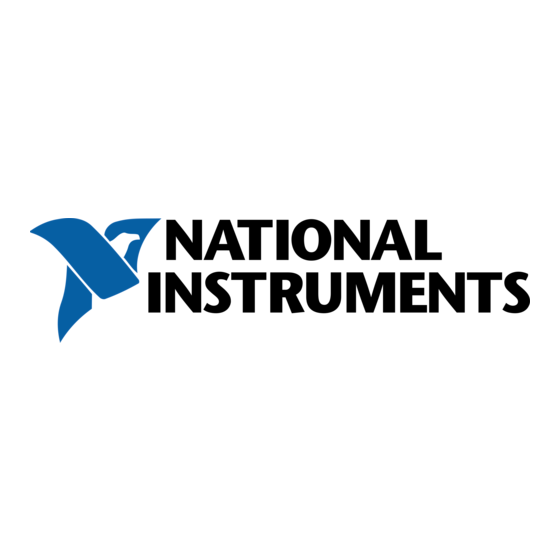Table of Contents
Advertisement
Quick Links
INSTALLATION GUIDE
NI TB-2706
PXI/PXIe Terminal Block for M Series and NI 6143 Devices
This installation guide describes how to install and connect signals to the NI TB-2706 terminal block
for use with PXI/PXIe M Series, NI PXI-6143, and other PXI/PXIe devices with a 68-pin VHDCI
connector.
Contents
Introduction.......................................................................................................................................... 1
What You Need to Get Started ............................................................................................................ 1
Safety Information ............................................................................................................................... 2
Connecting the Signals ........................................................................................................................ 3
Installing the Terminal Block .............................................................................................................. 5
Specifications....................................................................................................................................... 6
Where to Go for Support ..................................................................................................................... 7
Introduction
The TB-2706 is a terminal block assembly consisting of a printed circuit board, 70 screw terminals, and
a metal enclosure with strain relief hardware. The terminal block assembly connects directly to the front
panel of National Instruments PXI-622x, PXI-625x, PXIe-625x, PXI-628x, and PXI-6143 devices,
eliminating the need for an external cable.
The TB-2706 allows you to easily connect analog input, analog output, counter/timer, and digital I/O
signals to your National Instruments device. The 70 screw terminals allow access to every pin on the
connector, plus two shield screw terminals for use with a shielded cable. For M Series devices with
two connectors, this terminal block allows access to every pin on Connector 0, plus two shield screw
terminals for use with a shielded cable, but makes Connector 1 inaccessible.
Caution
The TB-2706 is not designed for input voltages greater than 42 V
install a voltage divider that reduces the voltage to within the input range of the DAQ device. Input
voltages greater than 42 V
host computer. Overvoltage also can cause an electric shock hazard for the operator. National
Instruments is not liable for damage or injury resulting from such misuse.
What You Need to Get Started
You need the following to set up and use your terminal block:
❑
NI TB-2706 Terminal Block Assembly
❑
NI TB-2706 Installation Guide
❑
NI PXI/PXIe M Series device, NI PXI-6143, or other PXI/PXIe device with a 68-pin VHDCI
connector
❑
M Series User Manual, S Series User Manual, or other PXI/PXIe DAQ device documentation
/60 VDC can damage the TB-2706, any device connected to it, and the
pk
/60 VDC, even if you
pk
Advertisement
Table of Contents

Summary of Contents for National Instruments Terminal Block NI TB-2706
-
Page 1: Installation Guide
The TB-2706 allows you to easily connect analog input, analog output, counter/timer, and digital I/O signals to your National Instruments device. The 70 screw terminals allow access to every pin on the connector, plus two shield screw terminals for use with a shielded cable. For M Series devices with two connectors, this terminal block allows access to every pin on Connector 0, plus two shield screw terminals for use with a shielded cable, but makes Connector 1 inaccessible. -
Page 2: Safety Information
National Instruments is not liable for any damages or injuries resulting from incorrect signal connections. -
Page 3: Connecting The Signals
Your kit contains a pinout label for M Series devices only, shown in Figure 2. This label, adhered to the inside of the cover, is a pin number-to-signal name reference. For PXI-6143 pin connections, refer to Figure 3 or the S Series User Manual. © National Instruments Corporation Strain-Relief Bar Signal Wire... - Page 4 Loosen or remove the strain-relief bar by loosening the two strain-relief screws with the Phillips-head screwdriver. Use wire cutters and wire insulation strippers to strip no more than 7 mm of insulation from the wire ends. Loosen the screws in the screw terminals with the 0.10 in. slotted screwdriver. Insert the stripped wires into the screw terminals.
-
Page 5: Installing The Terminal Block
Overvoltage also can cause an electric shock hazard for the operator. National Instruments is not liable for damage or injury resulting from such misuse. © National Instruments Corporation PXI/PXIe Chassis /60 VDC can damage the TB-2706, any device connected to it, and the... -
Page 6: Specifications
Specifications These specifications are typical at 25 °C unless otherwise specified. Input/Output Caution The TB-2706 is not designed for input voltages greater than 42 V Refer to the documentation for your M Series or PXI-6143 device to determine the input/output specifications for your application. -
Page 7: Where To Go For Support
National Instruments corporate headquarters is located at 11500 North Mopac Expressway, Austin, Texas, 78759-3504. National Instruments also has offices located around the world to help address your support needs. For telephone support in the United States, create your service request at and follow the calling instructions or dial 512 795 8248. - Page 8 Instruments trademarks. Other product and company names mentioned herein are trademarks or trade names of their respective companies. For patents covering National Instruments products, refer to the appropriate location: Help»Patents in your software, the patents.txt file on your CD, or ni.com/patents.














Need help?
Do you have a question about the Terminal Block NI TB-2706 and is the answer not in the manual?
Questions and answers